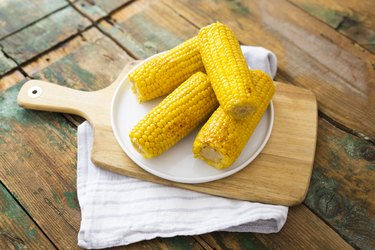
If you like to buy corn on the cob in bulk, but don't get to finishing every ear before it goes bad, you'll want to know the best methods for storing corn on the cob.
Whether you go with the fridge or the freezer, the key to keeping this tasty vegetable fresh is to act quickly.
Video of the Day
Video of the Day
How to Store Corn on the Cob
Unless you're eating your corn as soon as you bring it home from the store or the farmers' market, your best bet is to keep the corn cool.
Place the corn in the fridge or cover it with ice as soon as possible — doing so will help the corn retain its sweetness.
When corn isn't being kept cool, the enzymes in the kernels are more active and turn the sweet sugars into bland starch. An ear of corn can lose a significant amount of its sugar content when left at room temperature, according to the Academy of Nutrition and Dietetics.
How Long Does Corn on the Cob Last?
You can store corn on the cob in the refrigerator for around three days or in the freezer for up to 12 months.
Refrigerating Corn on the Cob
If your cobs come with the husks still attached, it's best to remove most of the husks, but allow a few to remain — enough to cover the whole cob. Doing so will give you more space in the refrigerator to store the corn, while also preventing the kernels from drying out.
If your ears of corn are already shucked, you can wrap the cob in plastic or foil before storing it in the fridge — this will help retain some moisture.
Whether shucked or with a few husks intact, you can store the cobs in a plastic or paper bag, but be sure it's loose-fitting. A tightly sealed bag may trap the corn's moisture, which may cause mold to form.
For maximum taste and freshness, don't store your fresh corn on the cob in the fridge for much longer than three days. If you're planning to eat the corn later in the week, your corn will taste better if stored in the freezer (more on that below).
Freezing Corn on the Cob
Freezing corn on the cob can be a good option when you have a large bounty or when you don't plan on eating the corn immediately.
Blanching is one method that helps ensure summer corn's sweetness lasts, as the process stops the enzymes that cause corn to lose its texture and flavor. Here's how, per Michigan State University Extension:
- Shuck the husks and silk from the ear.
- Blanch the ears for 4 minutes in boiling water.
- Once the 4 minutes are up, plunge the corn into ice water to stop them from cooking. Keep the corn in the ice water for about 7 to 11 minutes, depending on the size of the ears (larger ears need more time).
- Drain the corn.
- Wrap the dry ears of corn in a moisture-proof film and place them in a plastic freezer bag. Make sure to squeeze out all the air from the bag, which will prevent freezer burn.
- Seal the bag and label it with the date. The corn will remain fresh-tasting for up to one year.
Freezing Corn Kernels
You can also freeze the corn kernels, which will help save some space in your freezer. The process is similar to freezing the whole ear, except you'll cut the kernels off after blanching the whole corn.
Here's how to do it:
- Shuck the husks and silk from the ear.
- Blanch the ears for 4 minutes in boiling water.
- Once the 4 minutes are up, plunge the corn into ice water to stop them from cooking. Keep the corn in the ice water for 8 minutes.
- Drain and dry the corn.
- Cut the kernels off the cob and pack them into freezer-safe containers, leaving 1/2 inch of room beneath the lid.
- Seal and label your containers, which will keep the corn's quality for up to 12 months.
Storage Tips and How to Tell if Corn on the Cob Is Bad
Preserving taste and freshness and following proper food safety guidelines are often equated with meat, poultry and dairy products. But the process you use to prep and store vegetables such as corn is just as important.
Your first order of business is to check the temperature of your fridge and freezer. One of the best ways to prevent bacteria from invading your food is to keep your appliances at the proper temperature, according to the FDA. For the fridge, make sure the temp is set at or below 40 degrees Fahrenheit. The freezer temperature should be zero degrees Fahrenheit.
If you've had corn in the fridge longer than three days, be alert for anything that looks or smells suspicious. Per the FDA, keep an eye out for changes to the corn that may indicate that it's spoiled such as:
- Slime
- Mold
- Brown or black bits
Related Reading
- MissouriFamilies.org: From Harvest to Health: Corn
- U.S. Food and Drug Administration: "Are You Storing Food Safely?"
- Academy of Nutrition and Dietetics: "10 Surprising Foods You Should Be Refrigerating"
- Utah State University Cooperative Extension: "Corn"
- Pick Your Own: "Corn on the cob storing"
- Michigan State University Extension: "How to freeze corn now and enjoy it later"
- USDA: "Sweet corn on the cob"